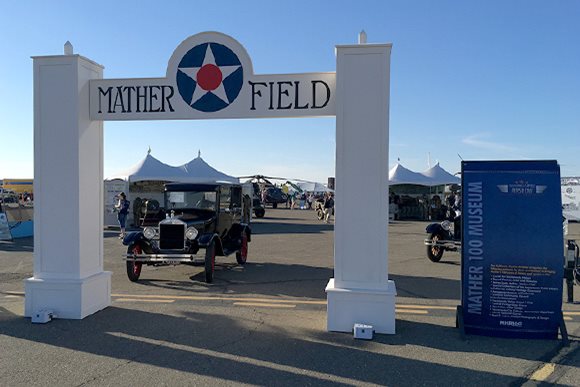"America had been at war for well over a year when just before 9 a.m. on July 4, 1918, a squadron from the newly established aviation school at Mather Field took off into an easterly-blowing headwind. Once over Sacramento, the 22 planes split into two formations with one descending on the city from the north, the other choosing to approach from the southeast. With thousands of stunned men, women, and children watching from city parks, street corners and the tops of city buildings, each formation fragmented into an avian circus of loops, dives, spirals, and treetop buzzes…all part of a promise made by base commander Lt. Col. Del Emmons to provide as many Valley residents as possible with an Independence Day thrill. Before their return to Mather, every plane descended to an elevation that was fit for dropping a friendly payload of Red Cross literature, Army and Navy recruiting posters, and hundreds of silken American flags."
The above passage — pulled from the Sacramento Room’s 2016
World War I and the Sacramento Valley (History Press: Charleston, SC) — may best capture the City of Sacramento’s lengthy love affair with Mather Field, a base standing sentinel to the east of the Capital City for over 100 years. Whether as one of the West Coast’s first aviation schools, the nation’s leading trainer of navigators or home to a Cold War B-52 bombardment wing, the base was, and always will be, part of the region’s cultural fabric. If, as writer William Faulkner says, “the past isn’t dead. It isn’t even past.” the Mather ethos is alive and well.
One of the finest efforts to draw attention to Mather’s immense past came with September’s California Capital Airshow and “Mather 100,” the brainchild of Colonel (USAF ret.) Bob Martinelli, Mather-trained navigator and the base’s last acting Commander. The temporary museum was composed of a fascinating array of in-depth storyboards, artifacts, re-enactors, murals and sets, including a replica of the Mather’s circa 1930 front gate, built by local artist and ex-Mather Airman Derrel Fleener.
“Having been assigned to Mather three times over my military career, much of the research and photos were a 'walk down memory lane,'” waxed Martinelli about his creation of Mather 100. “Using various sources, e.g. the Library, Center for Sacramento History, Facebook, etc., it was quite interesting to see what was 'out there' and reflect on my own time at Mather AFB over the years.”
To get off on the right foot for Mather 100, Martinelli visited the
Sacramento Room, which would come to be the source for much of the museum’s content. “We could not have put together the displays and narrative information without the assistance of [the Sacramento Room] and others with invaluable knowledge about Mather and its history.” Photographs, ephemera, and narrative from the Sacramento Room’s 2011
Mather Field were all used.
The museum’s debut was also supported by Sacramento Room archivist and librarian James C. Scott, who gave two presentations at the Mills Station Arts and Culture Center on both Mather’s full history and the facility’s World War I experience. Scott went on to provide interpretive assistance during the air show for Mather 100, while also promoting the Sacramento Room.
It’s amazing to think of Mather 100 sitting in the middle of a sunbaked tarmac that, just decades earlier, saw nuclear weapon-laden B-52s lumber on by. And, yet, that’s the beauty of history and certainly ample testament that the past is, indeed, never past.

For more information on the Mather saga, take a look at the following titles written by Sacramento Public Library:
This article featured in the January 2019 issue of
History in the Making. Subscribe.